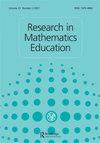Uniform persistence and backward bifurcation of vertically transmitted vector-borne diseases
IF 1.1
Q2 EDUCATION & EDUCATIONAL RESEARCH
引用次数: 0
Abstract
Vertical transmissions of vector-borne diseases such as dengue virus, malaria, West Nile virus and Rift Valley fever are among challenging factors in disease control. In this paper, we used a system of differential equations to study the impacts of vertical transmission (in the vector) and horizontal (vector-to-host) transmissions cycle on the uniform persistence of a vertically transmitted disease. This is given analytically when the secondary reproduction number is greater than unity. Additional numerical results indicate that vertical transmission rates raise the epidemic level. However, we provide analytical results to reveal that vertical transmission of the disease in vectors alone without horizontal transmission, could not make the disease endemic. Furthermore, by transforming the system of differential equations to a nonlinear eigenvalue equation, the existence of a backward bifurcation is established. The directions of bifurcation is forward when the disease-induced death rate of hosts is reduced below a threshold. It is shown that the bifurcation is backward when the disease-induced death rate in the host is above a critical value. Additionally, increased disease transmission parameters also contribute to backward bifurcation. Numerical results are also provided to highlight that, depending on the initial conditions, the disease could be persistent even when the secondary reproduction number is less than unity.垂直传播病媒传播疾病的统一持续性和后向分岔
登革热病毒、疟疾、西尼罗河病毒和裂谷热等病媒传播疾病的垂直传播是疾病控制方面的挑战因素之一。在本文中,我们使用一个微分方程组来研究垂直传播(在媒介中)和水平(媒介到宿主)传播周期对垂直传播疾病均匀持久性的影响。这是在二次繁殖数大于1时解析给出的。另外的数值结果表明,垂直传播率提高了流行程度。然而,我们提供的分析结果表明,疾病仅在媒介中垂直传播而没有水平传播,不能使疾病流行。进一步,通过将微分方程组转化为非线性特征值方程,证明了后向分岔的存在性。当宿主病死率降低到一定阈值以下时,分岔方向向前。结果表明,当宿主病死率高于临界值时,分岔是向后的。此外,疾病传播参数的增加也有助于后向分岔。数值结果还强调,根据初始条件,即使次级繁殖数小于1,该疾病也可能持续存在。
本文章由计算机程序翻译,如有差异,请以英文原文为准。
求助全文
约1分钟内获得全文
求助全文
来源期刊

Research in Mathematics Education
EDUCATION & EDUCATIONAL RESEARCH-
CiteScore
3.00
自引率
15.40%
发文量
40
 求助内容:
求助内容: 应助结果提醒方式:
应助结果提醒方式:


